Dynavector 1/48 XA2D-1 Skyshark
Why I am not standing in line for the new kit, good as I hear it is.
History
By the end of the Second World War, with operational analysis demonstrating that Navy fighter squadrons had protected the carrier-based strike aircraft so well that defensive crew-manned weapons had proven superfluoius, the Navy moved away from the multi-place dive bomber and torpedo bomber strike aircraft, and settled on one single-seat aircraft capable of undertaking both the dive bomber and torpedo strike roles, the Douglas AD Skyraider.
The Skyraider was good, but it was World War II technology, powered by a piston-engine, with performance little better than that of the aircraft it replaced so far as speed was concerned. The Navy looked at the jet engine and knew that was the future, they just didn't know how to bring jet engines onto carrier decks, while still providing the range and ordnance carrying-power necessary for carrier warfare.
One powerplant many designers were looking at on both sides of the Atlantic in the immediate postwar period was the turboprop, which seemed to offer higher speeds, while still offering low-speed controllability that would allow a turboprop-powered aircraft to operate off existing carrier decks. In England, this resulted in the Westland Wyvern strike aircraft, which saw limited service aboard Royal Navy carriers, but aquitted itself well in its one experience of combat, Operation Musketeer, known to history as the Anglo-French Suez Intervention of 1956.
Shortly after the Skyraider entered service and demonstrated its excellent qualities, Douglas Aircraft suggested a turboprop-powered evolutionary development. The airplane would be approximately the same size as the Skyraider and capable of similar load-carrying. With an aerodynamically cleaned-up airframe most notable in a much thinner wing, and with the 3,035 shaft horsepower with 1,225-lb exhaust thrust of the Allison T-40 turboprop, it was estimated the "Skyraider successor" would be capable of nearly an additional 200 mph top speed, while maintaining the range capability, maneuverability, and carrier qualification of the existing aircraft.
The Navy ordered the Douglas proposal as the XA2D-1 "Skyshark," with two prototypes. The first flew on May 26, 1950, with the second several months later. The two Skysharks were able early on to demonstrate that the estimated performance figures Douglas had quoted to the Navy were achievable; an order for 331 A2D-1s was made that fall as Chinese Communists armies overran the UN forces in North Korea and the Skyraider was proving its worth in the crucible of war.
Unfortunately, the Skyshark had an "Achilles heel," that being the main bearing of the Allison engine, which was basically two J-40 turbojets linked by this main bearing to provide power to the contra-rotating propellers. Allison seemed unable to overcome the problem.
At the same time that the Skyshark was undergoing the ordeal of being equipped with what turned out to be an undependable engine, Douglas' Chief Designer Ed Heineman proposed a new light attack airplane to the Navy. It would be turbojet-powered, it would have the range to hit the enemy, the speed an maneuverability to protect itself, and the ability to carry one of the new lightweight nuclear weapons.
With the advent of what would become the Douglas A4D-1 Skyhawk, the hulking Skyshark was cut back to five production aircraft, which only made limited flights before the Navy moved on to adopt state-of-the-art technology embodied in an airplane that would become known as one of the true "greats" of naval aviation.
Skyshark BuNo 125484 managed to evade the wrecker, and ended up out at the Planes of Fame Museum at Chino. Many museum visitors used to marvel at the huge airplane as it sat on the flightline, completely unflyable, but exuding a certain mystique in its look. This airframe still exists; after a few decades up in Idaho, the property of John Muszala, one of the original "Chino Kids," it was donated to the San Diego Air & Space Museum, where you can see it today in all its hulking grandeur.
The Kit:
Before the release of this Dynavector kit, the only other kits ever made of the Skyshark were a very old "desktop model" created by Allyn in about 1950, and a very nice 1/72 vacuform by Rareplanes, produced in the 1980s. The Allyn kit was picked up by Superscale in the early 1980s and released with new decals. I know several modelers - including myself - who attempted to bring this up to contemporary standards (it had - I believe - five parts, not counting the stand) with a scratchbuilt cockpit, scratchbuilt landing gear, vacuformed canopy, etc., etc. I never saw one finished, and my own ended up one of those boxes of parts that went out to become land-fill. The Rareplanes vacuform was - as was the case with most models from this company - very nice, with raised detail, and built up into a very acceptable model.
Dynavector began producing vacuform kits in the early 1990s, and this Skyshark was the sixth of their kits. It is the second most-popular Dynavector kit, the "soul mate" Westland Wyvern being their most popular kit; with over 3,700 sold world-wide, the Wyvern may be the most popular vacuform kit ever made. The Skyshark is a worthy companion.
Main parts are vacuformed on two large sheets of thick plastic. Detail parts, including cockpit detail, landing gear, props and underwing ordnance pylons, are in white metal. The decal sheet, which covers the three production Skysharks to ever fly, is from Fantasy Workshop. Earlier reviewers had noted that the white decals were not sufficiently opaque to successfully go over a Glossy Sea Blue paint scheme, but the decals from this kit - a new production copy made since Taro-san moved back to Japan - presented no problem when applied; it is likely the complaints were noted when new decals were printed.
Construction:
Construction of any vacuform starts with taking the parts off the backing sheet and sanding them down to fit. The parts are crisply-molded in this kit, and there was no problem cutting them off the sheet. And evening spent with some roug-grit sandpaper glued on a 2x4 took the parts down to acceptably-thin trailing edges, etc.
I opened the exhaust holes and the intake openings on the fuselage halves, thinned the exhaust holes down from inside, and glued in the white metal exhausts. I then took some thin Evergreen sheet and glued it to the centerline of the left fuselage half, to provide extra "mating surface" when the fuselage halves were glued together. I glued the intake interiors in position, then glued the fuselage halves together and set that aside.
The wing halves went together with no problem after I cut open the wheel wells and glued the vacuform wheel wells in position. Before assembling the wing, I drilled out all the holes on the lower wing for the attachment of ordnance pylons later.
I assembled the white metal cockpit consoles to the vacuyform tub, painted and detailed the cockpit in dark grey, attached the instrument panel to the fuselage interior separately, then glued in the cockpit. After that, I made some scratchbuilt bulkheads and glue them in position just aft of the cockpit and just ahead of the rear of the wing cutout, to provide some additional stiffness to the fuselage.
I then attached the wing subassembly to the fuselage, and attached the horizontal stabilizers. When the glue had set up, I applied putty to all the seams and joints and set that aside to dry overnight.
Next, I turned to the propeller assembly. I put CA glue into the vacuform spinners to strengthen them, allowing that to air-dry overnight. the next day, I cut out the circular openings for the propeller blades, attached the white metal backing parts, applied putty to the various assemblies and set that aside to dry while I sanded down the aiframe.
Once all the airframe seams were filled, I applied Mr. Surfacer, and got a smooth overall finish to the assembly. I rescribed panel lines where necessary.
Since I was going to assemble the model with the canopy closed, I decided to use an early injection-molded ejection seat instead of the poorly-done white metal seat provided.
To this point, the kit had assembled like a "Tamiya vacuform." The one big problem in the whole process was getting the canopy to fit smoothly. After gluing it in position, I found I had to use putty, sanding that down carefully afterwards, and three coats of Mr. Surfacer 500 to get a smooth overall connection. I had to repaint the Future on the outside of the canopy to deal with some sandpaper scratches, which came right out under the new coat of Future.
Painting:
The model was painted with Gunze-Sangyo "Midnight Blue" overall. After the first coat, I found some areas needing additional sanding, Mr. Surfacer 1000, and smoothing, but three thin coats resulted in a good-looking model.
Decals:
The kit decals went down with no problem. I did BuNo 125484 since it is the one that still exists. The decals were thick enough not to have any "bleed through" over the dark Glossy Sea Blue color.
Final Assembly:
I attached the painted propeller blades, and the wheels, then unmasked the canopy and painted the white "sealer" around the clear glass.
Overall:
Being "of a certain age" to have grown up reading books that had photos of all the "Fifties weirdos" of American aviation in that technologically fast-changing time, I have always liked the Skyshark for its "look." The kit catches that and brings this enigmatic airplane to life on my shelf. In case you wonder how big a Skyshark is, it is 3/4 the size of a B-25. Even in 1/48, it looks as massive as the original did when I would view it out at Chino ten years ago.
This is an easy vacuform that presents no insurmountable difficulties, and could be your "first vac" if you chose to do it, knowing you would have a good result in the end.
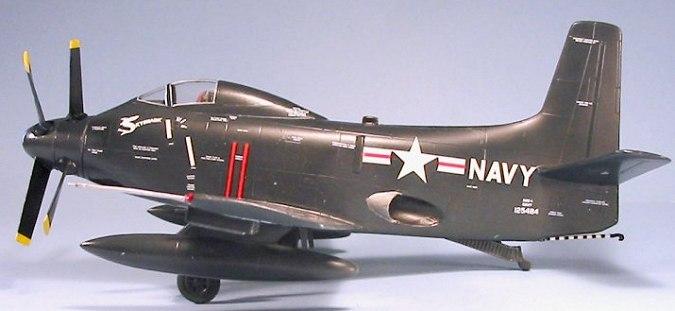
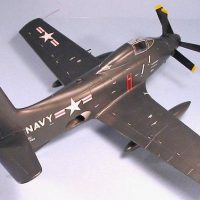
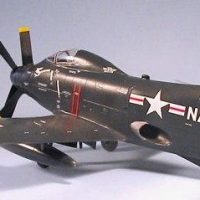
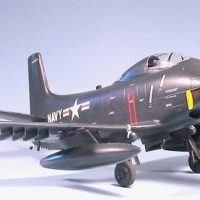
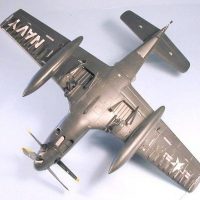
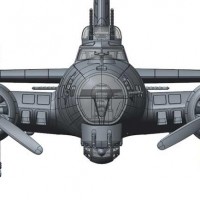
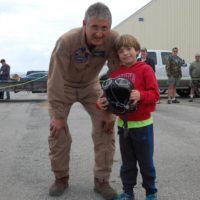
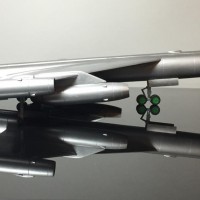

It is quite a nice build. It is much better than my Anigrand resin kit somewhere in the archives. I would like the ClearProp kit but not in a rush to get one (yet.)
Too bad Dynavector stopped making these kits. I actually have the Scimitar and it is on the pile of kits to be built (not right now as life has boiled over and stopped my model building.)
Beautiful work, Tom!
I love the aviation oddballs...
As always, Tom, a great background story taking us to a great build. For the first time I imagined gray/white or SEA painted A2-D’s dropping napalm during rescue missions. Damn bearings!
Wow, this is a very nice vacu-form build and pretty big too. It shows the beast inside this aircraft very well, great job.
A nice bit of Nav Air history, looks great!
Great model, Tom!
A great looking build, Tom.
I was not aware of this aircraft so thanks for sharing all the background.
Sweet build Tom. Excellent example of the dark art of vacform.
Nice job, Tom! Outside of diy vacuum formed parts, a vacuum form kit is one "genre" I have not attempted. Again, well done.
Great looking build. I've never built a vacuum form kit (I don't think I've ever seen one in person) but yours looks spectacular.
Looks amazing Tom, both the kit and the build. This vac-form looks like a high quality injection kit
I guess that losing out or being surpassed by the A-4 is not a bad thing.
Great build! Man - that army of pylons hanging beneath the wings definitely shows the lineage to it's big brother.
Very nice work on this Tom. Outstanding result.
Very nice Tom. Being a kid from the same period as you, seeing these airplanes from the sunset of the prop age is fun. Things were changing so fast from the late 40's to early 50's, it was hard to keep up with what was coming out next. Sadly nowadays, it takes 30+ years for a jet to go from design to full scale production.
And then it stays in service long enough for the grandchildren of the first pilots to become pilots flying it!